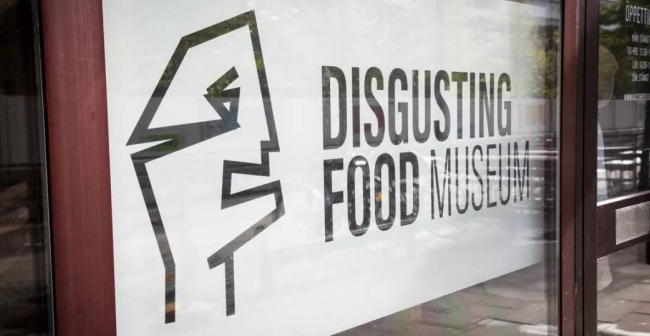
When it comes to food, one person’s “yuck” is another person’s “yum”. That was one of the major ideas behind the new Disgusting Food Museum, which opened recently in Malmo, Sweden. The museum’s founder, Dr. Samuel West, is a psychologist by day and a museum keeper by night. His first project, the Museum of Failure, was, quite strangely, a big hit.
But it was an article about meat consumption and its effect on the environment that inspired West to learn more about alternative sources of protein, and then to turn his new interest into a project. “If you ask people if they want to eat bugs, they say ‘that’s terrible’,” West says. “That’s the problem. But maybe I can make them reconsider.” The end result? A 400-square-meter olfactory experience, where visitors can feel, touch and taste different foods that have been considered “disgusting” around the world.
“What we find disgusting has to be learned—it’s purely cultural,” says West. To prove the point, American favorites like root beer and Jell-O salad sit in the museum alongside cooked guinea pigs. “If you give root beer to a Swede they will spit it out and say it tastes like toothpaste, but I think it’s delicious,” he notes.
After three months, he plans to take the show on the road and bring the museum to other cities. “We strongly identify culturally with the food we eat,” Hunt explains. “Part of travel is trying new food, and there’s a greater interest in trying new things.”
While many food-related “museums” have mostly just been opportunities for interesting pictures, West is sure that the Disgusting Food Museum is there to help people learn and think carefully, not just to pose for photos. The downside? Besides the potential of people getting sick, there’s also a restaurant next door that doesn’t want the museum’s more unusual exhibits leaking over into their space.
本时文内容由奇速英语国际教育研究院原创编写,未经书面授权,禁止复制和任何商 业用途,版权所有,侵权必究!(投稿及合作联系:微信:13350077298 QQ:757722345)
1.What does Disgusting Food Museum want to show actually?
A Different people like different foods.
B Some foods are not really delicious.
C A psychologist only works at night.
D The museum keeper is a good job.
解析:选A。推理判断题。根据第一段第一、二句When it comes to food, one person’s “yuck” is another person’s “yum”. That was one of the major ideas behind the new Disgusting Food Museum可知一个人讨厌的食物可能是另一个人眼中的佳肴,这是建立恶心食物博物馆最重要的理念之一,即它的展示目的是为了体现不同的人口味不同,故选A。
2.What made West have the idea of building the museum?
A The alternative eating sources.
B The passage about eating meat.
C The need to know failure.
D The interest to know new things.
解析:选B。细节理解题。根据第二段第一句But it was an article about meat consumption and its effect on the environment that inspired West to learn more about alternative sources of protein, and then to turn his new interest into a project.可知是一篇关于吃肉的文章激发韦斯特的想法的,故选B。
3.The underlined word “olfactory” may mean “______”.
A the place of factory
B the ability to travel
C the sense of smell
D the way to learn
解析:选C。词义猜测题。根据第二段最后一句的where visitors can feel, touch and taste different foods可知这个博物馆能让游客“品尝感觉食物”,由此可推知该词的意思应为“嗅觉”,故选C。
4.Why don’t Swedes like root beer?
A They like the cooked guinea pigs.
B It is due to the cultural differences.
C It is really made of the toothpaste.
D They just want to prove their ideas.
解析:选B。推理判断题。根据第三段第一句What we find disgusting has to be learned—it’s purely cultural可推知瑞典人不喜欢根汁汽水是因为文化的差异,故选B。
5.Which of the following is NOT true about the museum from the last paragraph?
A It provides an opportunity for visitors to take interesting pictures.
B It helps people learn and think carefully.
C It may make visitors feel disgusted.
D It has no effect on the nearby restaurant.
解析:选D。细节理解题。根据最后一段最后一句的there’s also a restaurant next door that doesn’t want the museum’s more unusual exhibits leaking over into their space可知该博物馆对附近的餐馆造成了一定的影响,故选B。